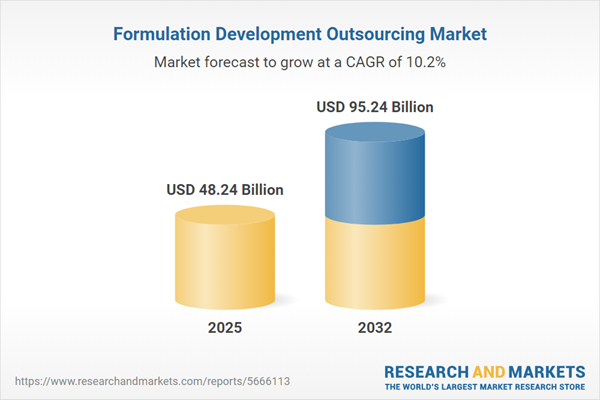Speak directly to the analyst to clarify any post sales queries you may have.
The Formulation Development Outsourcing Market enables senior decision-makers to streamline pharmaceutical R&D processes, enhance operational agility, and address complex formulation requirements through effective external partnerships. This approach offers organizations a way to respond efficiently to dynamic industry regulations and market conditions while optimizing resources.
Market Snapshot: Formulation Development Outsourcing Market Overview
In 2024, the Formulation Development Outsourcing Market is valued at USD 43.76 billion, with projected growth to USD 48.24 billion by 2025 and USD 95.24 billion by 2032. The sector demonstrates a compound annual growth rate of 10.20%. This expansion is underpinned by accelerating adoption of advanced supply chain solutions and increasing demand for specialist pharmaceutical R&D expertise. Industry leaders are turning to targeted outsourcing to support compliance, allocate resources efficiently, and safeguard competitive positioning. Global strategies emphasize digital transformation, regulatory adaptation, and resilient frameworks for growth in pharmaceutical innovation.
Scope & Segmentation of the Formulation Development Outsourcing Market
- Service Types: Analytical development, formulation development, pre-formulation analysis, regulatory filing support, method development and validation, stability studies, and sample analysis. Each service supports stringent quality control and compliance at critical research and manufacturing stages.
- Dosage Forms: Oral solids and liquids, parenteral products (including intravenous, intramuscular, subcutaneous), inhalation therapies, and topical routes such as creams, gels, ointments, and transdermal systems. This breadth enables tailored solutions for product portfolios.
- Contract Models: Options include fixed price, time and materials, and risk-sharing, offering flexibility to align projects with specific risk tolerance and operational requirements.
- Therapeutic Areas: Cardiovascular, central nervous system, infectious disease, metabolic disorder, and oncology projects benefit from dedicated expertise aligned with major pipelines.
- Geographic Regions: Americas, Europe, Middle East and Africa, and Asia-Pacific. Regions with mature regulatory and technology ecosystems—including the United States, Canada, Brazil, China, India, and Japan—facilitate effective cross-border partnerships and knowledge sharing.
- Leading Companies: Key participants like Catalent, Thermo Fisher Scientific, Lonza Group, Samsung Biologics, Recipharm, Vetter Pharma-Fertigung, Siegfried Holding, Jubilant Life Sciences, PCI Services, and Aenova Holding contribute with both local and international regulatory and technical solutions.
Key Takeaways for Senior Decision-Makers
- Outsourcing in formulation development allows executive teams to focus internal talent on strategic functions while leveraging specialized knowledge for complex formulation and regulatory tasks.
- Digital technology and artificial intelligence deliver improved project transparency and facilitate proactive management of development and supply chain risks at all phases.
- Flexible contract structures—such as hybrid or risk-sharing arrangements—provide organizations with responsive resource allocation and enable timely project adaptations.
- Expanding investments in biotechnology clusters and lesser-served regional markets increases technical capacity, positioning organizations to adapt to shifting compliance and innovation needs worldwide.
- Integrated regulatory and technology transfer services help manage supply chains efficiently and support streamlined cross-border compliance across jurisdictions.
Tariff Impact: Navigating Cost and Supply Chain Pressures
Anticipated U.S. tariff adjustments in 2025 are expected to impact procurement strategies and operational expenses for pharmaceutical outsourcing. To maintain supply continuity, executive teams are broadening supplier networks, enhancing regional sourcing models, and optimizing inventory controls to adapt to global trade developments.
Methodology & Data Sources
This report synthesizes direct interviews with executive leadership, insights from scientific and regulatory authorities, and proprietary real-time market tracking. The combination of qualitative and quantitative analysis ensures well-supported guidance for decision-makers committed to partnership optimization and supply chain resilience.
Why This Report Matters for Outsourcing and Procurement Leaders
- Actionable intelligence empowers procurement teams to refine sourcing and contract management, reinforcing agility within an increasingly complex global environment.
- Comprehensive risk analysis and market intelligence strengthen compliance strategies and support the stability of organizational value chains.
- Enhanced partner assessment processes align with strategic growth initiatives, enabling executives to identify innovation pathways and maintain competitive advancement.
Conclusion
Outsourcing formulation development enables pharmaceutical enterprises to increase efficiency, fuel innovation, and rapidly adapt to evolving regulatory and market forces. Strategic partnerships support sustainable business objectives and improved development agility.
Additional Product Information:
- Purchase of this report includes 1 year online access with quarterly updates.
- This report can be updated on request. Please contact our Customer Experience team using the Ask a Question widget on our website.
Table of Contents
3. Executive Summary
4. Market Overview
7. Cumulative Impact of Artificial Intelligence 2025
Companies Mentioned
The companies profiled in this Formulation Development Outsourcing market report include:- Catalent, Inc.
- Thermo Fisher Scientific Inc.
- Lonza Group AG
- Samsung Biologics Co., Ltd.
- Recipharm AB
- Vetter Pharma-Fertigung GmbH & Co. KG
- Siegfried Holding AG
- Jubilant Life Sciences Limited
- PCI Services LLC
- Aenova Holding GmbH
Table Information
| Report Attribute | Details |
|---|---|
| No. of Pages | 189 |
| Published | November 2025 |
| Forecast Period | 2025 - 2032 |
| Estimated Market Value ( USD | $ 48.24 Billion |
| Forecasted Market Value ( USD | $ 95.24 Billion |
| Compound Annual Growth Rate | 10.2% |
| Regions Covered | Global |
| No. of Companies Mentioned | 11 |









